 |
|

|
 |
TABLE of CONTENTS
 |
Completion of several high-profile projects marks end of 2011 construction season |
By Nick Carpenter
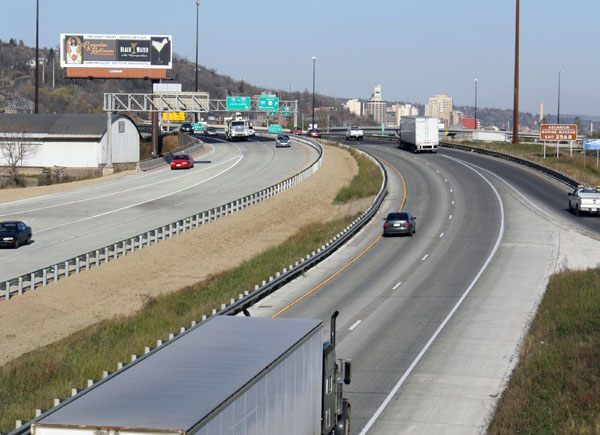
Motorists travel on a newly constructed segment of Interstate 35 south of downtown Duluth. Work is now substantially complete on the three-year I-35 Mega Project. Photo by Beth Petrowske |
The Interstate 35 Mega Project in Duluth, the Hwy 14 project between Waseca and Owatonna, and the Hwy 169/I-494 interchange in the Twin Cities Metro Area are among more than 250 state highway and bridge projects that were under construction in 2011.
“Crews worked hard this construction season to resurface roads, replace bridges, improve drainage systems, repair guard rail, install cable barriers and complete other vital transportation projects aimed at improving the quality of life for all Minnesotans,” said Commissioner Tom Sorel.
Of this year’s 258 state highway and bridge projects, 138 have been completed as of Nov. 9. The remaining 120 projects will either be completed by the end of 2011 or continue into next year or longer.
The 2011 construction season was interrupted in July by a three-week government shutdown. Since the return to work on July 21, MnDOT and crews have been working hard to make up lost time on construction projects, which has been helped considerably by a dry fall.
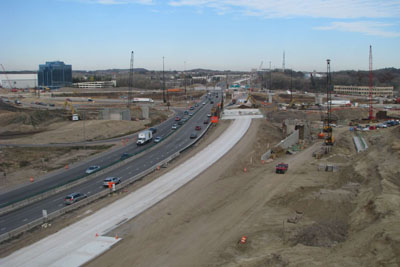
Work progresses on the Hwy 169/I-494 interchange reconstruction project in the southwestern Twin Cities Metro Area Nov. 8. MnDOT webcam photo |
Projects in the Twin Cities include:
- Hwy 169/I-494 interchange reconstruction project in the southwestern Twin Cities Metro Area–MnDOT saved more than $30 million on the project through a performance-based design process that allowed the department to critically evaluate needs against resources available to achieve the best low-cost, high-benefit solution for the traffic needs in the area. Work is scheduled for completion in November 2012. (Construction cost: $125 million)
- I-94 from the Fish Lake Interchange to Rogers in the northwestern Twin Cities Metro Area–Work is complete on the project, a collaborative effort between MnDOT and the city of Rogers that improved safety along I-94 to its connection with Hwy 101 in Rogers. (Construction cost: $28 million—MnDOT share: $22 million)
- Hwy 52 Lafayette Bridge project in St. Paul–The project began in January 2011 and is scheduled for completion in fall 2014. (Construction cost: $132 million)
- Hwy 169 Triangle project in the northwestern Twin Cities Metro Area–The recently reconstructed interchange at Hwy 169, County Road 81 and 85th Avenue will reduce congestion and improve safety for motorists. This was a collaborative project between MnDOT, Hennepin County and city of Brooklyn Park. (Construction cost: $51 million—MnDOT share: $35 million)
- Hwy 61 Hastings Bridge project over the Mississippi River–The project began in October 2010 and is scheduled for completion in late 2013. (Construction cost: $120 million)
Projects in northern and central Minnesota include:
- I-35 Mega Project in Duluth–Work is substantially complete on the project, which includes several safety improvements, such as wider shoulders, improved sight distance, and enhanced lighting and pavement markings. The three-year project is scheduled for completion in 2012. (Construction cost: $69 million)
- Hwy 23 expansion project between St. Cloud and Foley–The multi-year project is scheduled for completion in late 2012. (Construction cost: $26 million)
- Hwy 371 reconstruction project between Baxter and Nisswa–Work is complete on the 13-mile project, which includes upgraded traffic signals, new turn lanes and a resurfaced road. (Construction cost: $8.4 million)
- Hwy 71/Highway 197 expansion project on the south end of Bemidji—Work is nearing completion on this six-mile project, which is expanding the highway from two lanes to four—five lanes in the city of Bemidji—and adding a new bridge over Hwy 2. (Construction cost: $24 million)
- Hwy 75/Clay County Road 12 roundabout project south of Moorhead—Work is complete on the roundabout, which is the first to be completed on a state highway in west central Minnesota. (Construction cost: $2.2 million)
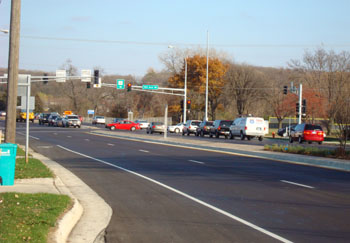
Hwy 14 traffic comes to a halt at 11th Avenue Southeast in Rochester. Crews recently completed work on a $6 million resurfacing project on Hwy 14 between Hwy 52 and Marion Road. Photo courtesy of District 6 |
Projects in southern Minnesota include:
- Hwy 14 between Waseca and Owatonna—Work is progressing on the multi-year project, which includes a new interchange at I-35 and Hwy 14. Construction is ongoing and is scheduled for completion in summer 2012. (Construction cost: $107.8 million)
- Hwy 14 resurfacing project in Rochester—Work is complete on the project, which included curb and gutter work, landscaping, new bike trails and fiber-optic technology. (Construction cost: $6 million)
- Hwy 23 bypass project in Paynesville–Construction began in spring 2009 and is scheduled for completion in August 2012. (Construction cost: $32.2 million)
- Hwy 60 four-lane expansion project between Worthington and Bigelow–The three-phase project began in summer 2010 and is scheduled for completion in 2013. (Construction cost: $45 million)
- Hwy 83 resurfacing project from Mankato to Hwy 30–Work is nearing completion on the project, with Hwy 83 scheduled to open in early November. (Construction cost: $10 million)
For a list of recently completed projects, visit www.dot.state.mn.us/roadwork/complete.html; ongoing projects, visit www.dot.state.mn.us/roadwork/current.html; and future projects, visit www.dot.state.mn.us/roadwork/future.html.
Although the majority of 2011 construction work is coming to an end, work on several projects throughout the state will continue through the winter as weather permits. |
 |
|

|
 |
TABLE of CONTENTS
 |
Minnesota receives $1.2 million federal transit grant for veterans, military families |

(From left) Commissioner Tom Sorel shakes hands with Federal Transit Administrator Peter Rogoff Nov. 9 at a news conference in St. Paul announcing a $1.2 million grant MnDOT is receiving from the FTA as part of the USDOT Veterans Transportation and Community Living Initiative Capital Grants Program. Photo by Adam Peterson
|
MnDOT received a $1.2 million grant from the Federal Transit Administration to create a transportation referral system that will improve transportation options and mobility for Minnesota’s veterans, service members, their families and other Minnesota residents.
The grant is from the USDOT Veterans Transportation and Community Living Initiative Capital Grants Program, which had $30 million in discretionary funds to distribute.
“It is very appropriate that we acknowledge this grant two days before Veterans Day,” said Commissioner Tom Sorel. “This will help us expand needed transportation services for our veterans and their families. The application was a collaborative project and we greatly appreciate the work of all of our partners.”
Federal Transit Administrator Peter Rogoff made the announcement at a news conference held Nov. 9 at the Veterans Service Building in St. Paul. Minnesota Congresswoman Betty McCollum; Commissioner Sorel; Jean Wood, executive director, Minnesota Board on Aging; and Mike Schadauer, MnDOT Transit director, also spoke at the event.
The project will augment an existing statewide one-call/one-click center with technology and information about public, not-for-profit, and private transportation alternatives for veterans, military families, people with disabilities, and older adults.
As proposed, the transportation referral system would be developed in four phases:
- Phase 1 – Builds a transportation information referral system for a 27-county region in southwestern Minnesota.
- Phase 2 – Builds a database of transportation data in all of Greater Minnesota (outside the seven-county Twin Cities Metro area) and a trip planner interface.
- Phase 3 – Builds a transportation information referral system for a 14-county region in west central Minnesota.
- Phase 4 – Builds a transportation information referral system for a seven-county area in northeastern Minnesota.
The project is expected to take three to four years to accomplish, according to Schadauer. |
 |
|

|
 |
TABLE of CONTENTS
 |
Post-shutdown preparations ensure plow drivers are ready for winter |
|
By Jessica Wiens Forecasters are predicting Minnesota will experience another winter of above normal snowfall and below normal temperatures. Southeastern Minnesota got the first small taste of winter Wednesday morning—the Preston/Caledonia area received two inches of snow accumulation.
Maintenance crews across the state prepare year-round for snow and ice, and July’s three-week state government shutdown created some delays and headaches for this year’s prep work. When employees returned, maintenance staff quickly implemented a post-shutdown plan that put snow and ice at the top of the priority list.
“All things considered, we’re looking ready to go,” said Curt Larson, District 2 Maintenance superintendent. “Fall has been really dry and really nice, so that has helped us catch up on winter prep and other areas.”
Each year, more than 800 snow plows must go through a standard commercial vehicle inspection along with additional prep work, such as ensuring the salt and sand spreaders are properly calibrated and the plows, wings and other added equipment are functioning correctly.
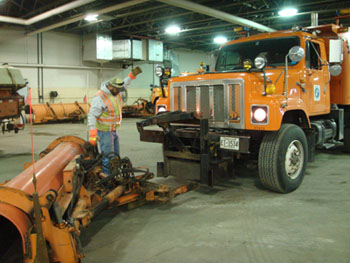
(From left) Chad Lisser and plow driver Reggie Shones, Rochester Truck Station, connect a front plow to a truck. Several District 6 crews prepared for potential snow and rain Nov. 8-9. The storm moved further east than expected and only the Preston/Caledonia area received minor accumulations. Photo by Kristin Kammueller
|
“Our mechanics and inspectors spent many weeks doing overtime to get the trucks ready,” said Mark Fischbach, Metro Maintenance/clear roads superintendent. “It’s amazing how three weeks could affect progress so much, but we’re finally caught up now.”
The state government shutdown also created a shortened time to hire new plow drivers before the annual Snow Plow Operator Training in September at Camp Ripley. More than 100 new plow drivers attended SPOT this season. The number of new drivers is higher than average this year due to the many veteran employees who took advantage of the early retirement incentive.
One area the shutdown did not affect is salt. Last year, MnDOT used nearly 268,000 tons of salt—up from about 180,000 tons in 2009-10. Many salt sheds across the state were virtually empty in spring 2011, so maintenance spent approximately $7 million in June to fill those salt sheds and have them ready to go for this season.
Technology and equipment advances
MnDOT is increasing use of the Maintenance Decision Support System. MDSS is an in-cab expert computer system that provides real-time weather forecasts and aids snowplow operators in making decisions about which materials to apply and at what rate to apply them. Currently, about 80 MnDOT plows have this system installed. By the end of 2012, more than 225 plows will have the technology installed.
In addition, District 7 is preparing to use new liquid dispensing stations at the Mankato and Windom truck stations. The system dispenses salt brine, calcium chloride or other blends of liquid materials that improve road conditions.
Plow drivers simply enter their truck number and employee pin. The system knows how much material the truck can hold, at what rate the truck can receive the material and what blend of materials are recommended for that plow’s route. This system, which is funded through maintenance research, ensures that the right amount of material is used at the correct time to improve road conditions.
“When the temperatures are warm, straight salt brine is most likely the right product,” said Tom Zimmerman, District 7 Maintenance superintendent. “When temperatures dip to below zero, a higher concentration of calcium chloride is needed.”
Metro District has four tow plows in its fleet this season for plowing interstates and four-lane highways. District 3 has two additional tow plows. A tow plow is a trailer-mounted plow that is pulled and operated from a snowplow. The 26-foot-wide plow allows one operator to clear one or two lanes of highway in one pass.
“Vehicles really respect the tow plows,” Fischbach said. “Motorists see that huge truck and they stay far behind it.”
Winter Hazard Awareness Week is Nov. 7-11, with Friday, Nov. 11, focusing on winter driving. Visit www.mndot/gov/workzone for information on snowplow safety. |
 |
|

|
 |
TABLE of CONTENTS
 |
Wendy Friede assumes employee ombudsman role |

Wendy Friede, principal of Friede Coaching and Consulting, recently began her new role as MnDOT’s first-ever employee ombudsman. Photo courtesy of Wendy Friede |
Wendy Friede, principal of Friede Coaching and Consulting, recently began her new role as MnDOT’s first-ever employee ombudsman—a function created to serve as an informal, independent and neutral resource for employees to use when they have workplace issues.
In her role as employee ombudsman, Friede will serve as a complement to department’s current formal resources, rather than a competitor or duplicate.
“If you know where to go and feel comfortable going there, go directly there,” Friede said. “If you’re not comfortable with those resources and want someone to talk to, the employee ombudsman is an option for you.
“My main job is to listen, to really help employees be heard and help them clarify what their real issue is,” Friede said. “I look forward to helping employees have a voice and a safe place to consider their options.”
Friede is a trained mediator, certified Ombudsman and coach who has worked 18 years in the public and private sector. She served on the International Ombudsman Board of Directors and has taught new ombudsman training for more than 10 years.
Friede has bachelor’s degree in Education from the University of Minnesota and a master’s degree in Instructional Media and Design from Boston University.
Employees can contact Friede at 651-366-3064 or toll free outside of the Twin Cities Metro Area at 1-855-259-6363.
For more information on the new employee ombudsman function, visit ihub.dot.state.mn.us/ombudsman/. |
 |
|

|
 |
TABLE of CONTENTS
 |
E-JAM2 launches Nov. 9 |
By Bob Filipczak
E-JAM2, MnDOT’s second E-magination JAM, officially launched Nov. 9.
E-JAM2 is a virtual space where employees can submit ideas that focus on new cost saving concepts and share information about what the department is doing to increase efficiency in operations. These can be new ideas, or concepts employees have already implemented in their own area that other offices or districts could benefit from.
The process:
- Visit the E-JAM2 website, which will be live for two weeks
- Register and confirm registration via e-mail
- Start submitting ideas
- Vote or comment on other ideas that have been submitted
Some of the ideas will need to be discussed further to be implemented; however, employees are encouraged to review submissions and determine if they can implement any of the ideas immediately.
For more information on E-JAM2, visit ihub/emaginationjam/index.html. |
 |
|

|
 |
TABLE of CONTENTS
 |
Using technology to make meetings smarter |
By Bob Filipczak
Next time you go to a meeting in a MnDOT conference room, look up. Chances are good that you will see one of the new SMART Boards that have been installed in more than 20 meeting rooms around the state.
SMART Boards are interactive whiteboards with a built-in computer, cameras that track everything written on the board, and audio. Just show up to your next meeting, log into the network using a wireless mouse and keyboard, and you can have your computer presentation up and running immediately. You can even share your presentation with others who have SMART Boards installed in their meeting rooms.
Installing SMART Boards, which run on a software called Bridgit, was one of the projects sponsored by the Tech Connections Flagship Initiative.
“Making our meetings more effective was a primary driver for this technology. We needed technology people could intuitively pick up and feel comfortable with. These SMART Boards answered a lot of our needs for smarter meetings in one package,” said Kris Schulze, Tech Connections Initiative project manager.
There are a lot of tangible benefits to the SMART Boards, including more collaboration, less paper and less travel. Don’t want to type? Use the interactive markers in the tray of the SMART Board (but don’t use any other marker!) and mark up your documents, spreadsheets, CAD drawings or maps. You can then save the marked up copy, and if you’re connected to another SMART Board, they will see what you draw on the board.
Angela Finn, division business coordinator, uses SMART Boards to discuss contracts with district employees.
“The remote collaboration has reduced travel costs, and I know if I need to hold a meeting with a different district, that can happen within minutes,” said Finn.
“You will need to give Bridgit a little extra time to sync up with your Outlook account once you are logged in,” said Schulze, “but once it is communicating with the other boards, you’re totally connected.”
You can find more how-to information and the Central Office conference room equipment list, on the iHUB Conference Room site. |
 |
|

|
 |
TABLE of CONTENTS
 |
Open enrollment continues through Nov. 15 |
This year’s open enrollment period, which allows you to change your benefits election for the upcoming calendar year, will end Nov. 15 at midnight.
Currently, there are no changes to the medical and dental plans, and no changes to the premium rates, because the state and unions are still in the bargaining process, according to Minnesota Management and Budget. However, there is a possibility that they will negotiate changes that will be effective sometime in 2012. If this happens, enrollment options will be determined and communicated at that time.
Check the MMB open enrollment website at www.mmb.state.mn.us/oe for details about how to enroll. For a quick overview of open enrollment options, click here.
Keep in mind:
- If you wish to participate in the pre-tax accounts, you must enroll every year, even if you are currently participating.
- You must complete the health assessment and agree to a follow-up call by a health coach to receive the lower office visit copayment in the Advantage Health Plan.
- If you do not want to make changes to your health, dental and long-term disability, you do not have to re-enroll. However, even if you decide to keep your current coverage, your costs may change in 2012.
Note that this year there are a number of technical changes concerning the definitions of dependents that bring the definitions into conformity with state and federal law. Those definitions are found at www.mmb.state.mn.us/dep-elig. If your dependents do not meet these definitions and, therefore, are not eligible to participate, you should use the open enrollment period to drop them from coverage.
If you have any questions, contact these MnDOT representatives:
- Andy Gibbens – 651-366-3405
- Sue Ronchak – 651-366-3368
- Connie Eystad – 651-366-3398
|
 |
|

|
 |
TABLE of CONTENTS
 |
New Library Materials posted on Web |
By Qin Tang
The October 2011 edition of New Library Materials is now available at www.dot.state.mn.us/library/newlibmat.html.
The MnDOT Library not only serves employees, it serves Minnesota city and county staff, and the general public. In this issue of New Library Materials, check out the library’s greeting to Minnesota city and county engineers.
Archived editions of New Library Materials are available at www.dot.state.mn.us/library/recacq-archive.html.
New Library Materials is a compilation of new titles and other resources added to the library collection during the previous month. If you would like to receive this list, contact Pam Gonzalez at 651-366-3749.
For other information requests, contact the library at 651-366-3791 or email library.dot@state.mn.us. Employees can also send requests via the “Ask a Librarian” webpage at www.dot.state.mn.us/library/asklibrarian.html. |
 |
|

|
 |
TABLE of CONTENTS
 |
Employees statewide contribute to sustainability efforts |
By Teresa Chapman, Sustainability Team manager
As we settle back into our fall routines, it’s a good time to take a look around and think about how each of us can reduce waste and save money in our workplace by simply practicing the three R’s—Reduce, Reuse and Recycle.
In celebration of America Recycles Day on Nov. 15, let’s take a look at some of the things employees across the state are doing on the job to increase sustainability, one of MnDOT’s flagship initiatives.
Covering the basics in St. Cloud
District 3 employees in St. Cloud collect both paper and cardboard at each desk and work area. The material is then transferred to larger containers for weekly recycling. In addition, cans and plastic bottles are collected biweekly throughout the St. Cloud headquarters.
Pat Poepping, the building services lead, is also helping the district increase sustainability by buying cleaners that work on multiple surfaces.
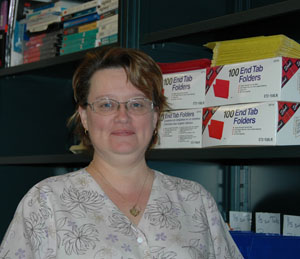
Michelle Travers, Central Office Inventory Center and Supplies, stands by shelves of “up-for-grabs” office supplies located in the CO Inventory Center. Photo by Lisa Yang |
Reusing office supplies at Central Office
Michelle Travers, Central Office Inventory Center and Supplies, has made it her mission to recycle and reuse office supplies.
Over the years, Travers has shown employees how to get the most for their money when ordering supplies and through the reuse of supplies. For example, if an office special orders too many folders, they can return the overstock to Travers. She will credit the office for the unused folders and notify personnel responsible for ordering supplies that the folders are available. If no one is interested or the supplies have been around too long, Travers will send them to Administration Fleet & Surplus Services in Arden Hills, where they can be purchased by any government entity.
Travers also is a resource for people when they leave or retire. Instead of dumping everything into a bin that then goes into the trash, retiring employees can contact Travers and she’ll take their useable supplies and make them available to others.
Clean Out Day at the Bridge Office
The Bridge Office holds a yearly office Clean Out Day when employees are encouraged to clean out their workstations and ensure items that are no longer useful are reused, recycled or otherwise properly disposed of:
- Office supplies no longer needed are dropped off at one work station and made available to other employees.
- Items not needed by Bridge Office employees are boxed up and sent to Michelle Travers at CO to see if any other employees can use them.
- Hazardous materials, dead batteries and broken electronics are disposed of.
- Recyclable materials, soda cans, juice jars and printed copies of documents that are no longer needed are put into bins for recycling.
Golden Valley weighs in
The following items were collected, recycled or otherwise safely and appropriately disposed of by staff in Golden Valley during 2010:
- Tires – 70 tons
- Treated wood – 85.7 tons
- Appliances (abandoned on highways) – 50 pieces
- Used oil – 6,135 gallons
- Fluorescent bulbs – 3,380 bulbs
- Vehicle batteries – 350
- Alkaline batteries – several boxes
District 1 "recycles" buildings...and more
District 1 is undertaking a new effort to “recycle” buildings that are removed for construction. MnDOT is beginning to contract with firms that will sort through debris—wood, metal, bricks and carpet—and recycle each component. When this technique is applied, 90-95 percent of the structure is reused.
District 1 and others around MnDOT use a host of practices to ensure construction material and debris is reused or recycled. A few of these include:
- Recycling as much bituminous as possible and transporting the remainder for use on other projects
- Recycling rebar at a metal recycling facility
- Reusing concrete as base material or in new cement
More details on all of these activities and more can be found at: ihub/emaginationjam/greenteam.html. For more information on America Recycles Day, visit americarecyclesday.org.
Employees with examples of what their district/office is doing in regards to sustainability should send them to Teresa.Chapman@state.mn.us. They will be posted on the iHUB Sustainability webpage.
Recycling brown bag event
AccessAbility, Inc., Central Office's recycling service, will be featured at a brown bag luncheon about recycling at the capitol complex.
- Tuesday, Nov. 15
- 11:30 a.m. – 12:30 p.m.
- Central Office, Room G-13
|
|
 |
|
| |
|



